|
|
| |
|
|
| |
|
|
|
|
| |
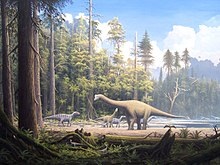 |
| Dinosaurs were the
dominant terrestrial vertebrates throughout much
of the Mesozoic. |
Mesozoic
The Mesozoic Era ( /ˌmɛz.əˈzoʊ.ɪk, ˌmɛz.oʊ-, ˌmɛs-, ˌmiː.zə-,
-zoʊ-, ˌmiː.sə-, -soʊ-/ mez-ə-ZOH-ik, mez-oh-, mess-,
mee-zə-, -zoh-, mee-sə-, -soh-) meaning "middle life"
is the middle of the three geological eras of the
Phanerozoic Eon. It lasted from about 252 to 66 million
years ago. It is also called the Age of Reptiles and the
Age of Conifers.
The Mesozoic was preceded by the Paleozoic ("ancient
life") and succeeded by the Cenozoic ("new life"). The
era is subdivided into three periods: the Triassic,
Jurassic, and Cretaceous, which are further subdivided
into a number of epochs and stages.
The era began in the wake of the Permian–Triassic
extinction event, the largest well-documented mass
extinction in Earth's history, and ended with the
Cretaceous–Paleogene extinction event, another mass
extinction whose victims included the non-avian
dinosaurs. The Mesozoic was a time of significant
tectonic, climate, and evolutionary activity. The era
witnessed the gradual rifting of the supercontinent
Pangaea into separate landmasses that would move into
their current positions during the next era. The climate
of the Mesozoic was varied, alternating between warming
and cooling periods. Overall, however, the Earth was
hotter than it is today. Dinosaurs first appeared in the
Mid-Triassic, and became the dominant terrestrial
vertebrates in the Late Triassic or Early Jurassic,
occupying this position for about 150 or 135 million
years until their demise at the end of the Cretaceous.
Birds first appeared in the Jurassic (however, true
toothless birds appeared first in the Cretaceous),
having evolved from a branch of theropod dinosaurs. The
first mammals also appeared during the Mesozoic, but
would remain small—less than 15 kg (33 lb)—until the
Cenozoic. The flowering plants (angiosperms) appeared in
the Early Cretaceous and would rapidly diversify
throughout the period, replacing conifers and other
gymnosperms as the dominant group of plants.
Naming
The phrase "Age of Reptiles" was introduced by the 19th
century paleontologist Gideon Mantell who viewed it as
dominated by diapsids such as Iguanodon, Megalosaurus,
Plesiosaurus, and Pterodactylus.
Mesozoic means "middle life", deriving from the Greek
prefix meso-/μεσο- for "between" and zōon/ζῷον meaning
"animal" or "living being". The name "Mesozoic" was
proposed in 1840 by the British geologist John Phillips
(1800–1874).
The Mesozoic era was originally described as the
"secondary" era, following the primary or Paleozoic, and
preceding the Tertiary. |
|
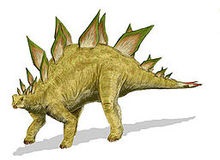 |
| Stegosaurus. |
Geologic periods
Following the Paleozoic, the Mesozoic extended roughly
186 million years, from 251.902 to 66 million years ago
when the Cenozoic Era began. This time frame is
separated into three geologic periods. From oldest to
youngest:
Triassic (251.902 to 201.3
million years ago)
Jurassic (201.3 to 145
million years ago)
Cretaceous (145 to 66
million years ago)
The lower boundary of the Mesozoic is set by the
Permian–Triassic extinction event, during which it has
been estimated that up to 90-96% of marine species
became extinct[7] although those approximations have
been brought into question with some paleontologists
estimating the actual numbers as low as 81%. It is also
known as the "Great Dying" because it is considered the
largest mass extinction in the Earth's history. The
upper boundary of the Mesozoic is set at the Cretaceous–Paleogene
extinction event (or K–Pg extinction event), which may
have been caused by an asteroid impactor that created
Chicxulub Crater on the Yucatán Peninsula. Towards the
Late Cretaceous, large volcanic eruptions are also
believed to have contributed to the Cretaceous–Paleogene
extinction event. Approximately 50% of all genera became
extinct, including all of the non-avian dinosaurs. |
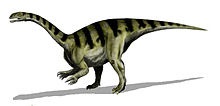 |
| Plateosaurus (a
prosauropod). |
Triassic
The Triassic ranges roughly from 252 million to 201 million
years ago, preceding the Jurassic Period. The period is
bracketed between the Permian–Triassic extinction event and
the Triassic–Jurassic extinction event, two of the "big
five", and it is divided into three major epochs: Early,
Middle, and Late Triassic.
The Early Triassic, about 252 to 247 million years ago, was
dominated by deserts in the interior of the Pangaea
supercontinent. The Earth had just witnessed a massive
die-off in which 95% of all life became extinct, and the
most common vertebrate life on land were Lystrosaurus,
labyrinthodonts, and Euparkeria along with many other
creatures that managed to survive the Permian extinction.
Temnospondyls evolved during this time and would be the
dominant predator for much of the Triassic.
The Middle Triassic, from 247 to 237 million years ago,
featured the beginnings of the breakup of Pangaea and the
opening of the Tethys Ocean. Ecosystems had recovered from
the Permian extinction. Algae, sponge, corals, and
crustaceans all had recovered, and new aquatic reptiles
evolved, such as ichthyosaurs and nothosaurs. On land, pine
forests flourished, as did groups of insects like mosquitoes
and fruit flies. Reptiles began to get bigger and bigger,
and the first crocodilians and dinosaurs evolved, which
sparked competition with the large amphibians that had
previously ruled the freshwater world, respectively
mammal-like reptiles on land.
Following the bloom of the Middle Triassic, the Late
Triassic, from 237 to 201 million years ago, featured
frequent heat spells and moderate precipitation (10–20
inches per year). The recent warming led to a boom of
dinosaurian evolution on land as those one began to separate
from each other (Nyasasaurus from 243 to 210 million years
ago, approximately 235–30 ma, some of them separated into
Sauropodomorphs, Theropods and Herrerasaurids), as well as
the first pterosaurs. During the Late Triassic, some
advanced cynodonts gave rise to the first Mammaliaformes.
All this climatic change, however, resulted in a large
die-out known as the Triassic–Jurassic extinction event, in
which many archosaurs (excluding pterosaurs, dinosaurs and
crocodylomorphs), most synapsids, and almost all large
amphibians became extinct, as well as 34% of marine life, in
the Earth's fourth mass extinction event. The cause is
debatable; flood basalt eruptions at the Central Atlantic
magmatic province is cited as one possible cause. |
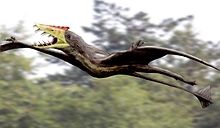 |
| Sericipterus. |
Jurassic
The Jurassic ranges from 200 million years to 145 million
years ago and features three major epochs: The Early
Jurassic, the Middle Jurassic, and the Late Jurassic.
The Early Jurassic spans from 200 to 175 million years ago.
The climate was tropical, much more humid than the Triassic.
In the oceans, plesiosaurs, ichthyosaurs and ammonites were
abundant. On land, dinosaurs and other archosaurs staked
their claim as the dominant race, with theropods such as
Dilophosaurus at the top of the food chain. The first true
crocodiles evolved, pushing the large amphibians to near
extinction. All-in-all, archosaurs rose to rule the world.
Meanwhile, the first true mammals evolved, remaining
relatively small but spreading widely; the Jurassic
Castorocauda, for example, had adaptations for swimming,
digging and catching fish. Fruitafossor, from the late
Jurassic period about 150 million years ago, was about the
size of a chipmunk, and its teeth, forelimbs and back
suggest that it dug open the nests of social insects
(probably termites, as ants had not yet appeared). The first
multituberculates like Rugosodon evolved, while
volaticotherians took to the skies.
The Middle Jurassic spans from 175 to 163 million years ago.
During this epoch, dinosaurs flourished as huge herds of
sauropods, such as Brachiosaurus and Diplodocus, filled the
fern prairies, chased by many new predators such as
Allosaurus. Conifer forests made up a large portion of the
forests. In the oceans, plesiosaurs were quite common, and
ichthyosaurs flourished. This epoch was the peak of the
reptiles.
The Late Jurassic spans from 163 to 145 million years ago.
During this epoch, the first avialans, like Archaeopteryx,
evolved from small coelurosaurian dinosaurs. The increase in
sea levels opened up the Atlantic seaway, which has grown
continually larger until today. The divided landmasses gave
opportunity for the diversification of new dinosaurs. |
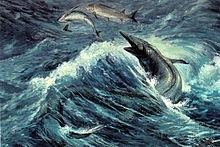 |
| Tylosaurus (a
mosasaur) hunting Xiphactinus. |
Cretaceous
The Cretaceous is the longest period of the Mesozoic, but
has only two epochs: Early and Late Cretaceous.
The Early Cretaceous spans from 145 to 100 million years
ago. The Early Cretaceous saw the expansion of seaways, and
as a result, the decline and/or extinction of Laurasian
sauropods. Some island-hopping dinosaurs, like
Eustreptospondylus, evolved to cope with the coastal
shallows and small islands of ancient Europe. Other
dinosaurs rose up to fill the empty space that the
Jurassic-Cretaceous extinction left behind, such as
Carcharodontosaurus and Spinosaurus. Seasons came back into
effect and the poles got seasonally colder, but some
dinosaurs still inhabited the polar forests year round, such
as Leaellynasaura and Muttaburrasaurus. The poles were too
cold for crocodiles, and became the last stronghold for
large amphibians like Koolasuchus. Pterosaurs got larger as
genera like Tapejara and Ornithocheirus evolved. Mammals
continued to expand their range: eutriconodonts produced
fairly large, wolverine-like predators like Repenomamus and
Gobiconodon, early therians began to expand into
metatherians and eutherians, and cimolodont
multituberculates went on to become common in the fossil
record.
The Late Cretaceous spans from 100 to 66 million years ago.
The Late Cretaceous featured a cooling trend that would
continue in the Cenozoic era. Eventually, tropics were
restricted to the equator and areas beyond the tropic lines
experienced extreme seasonal changes in weather. Dinosaurs
still thrived, as new taxa such as Tyrannosaurus,
Ankylosaurus, Triceratops and hadrosaurs dominated the food
web. In the oceans, mosasaurs ruled, filling the role of the
ichthyosaurs, which, after declining, had disappeared in the
Cenomanian-Turonian boundary event. Though pliosaurs had
gone extinct in the same event, long-necked plesiosaurs such
as Elasmosaurus continued to thrive. Flowering plants,
possibly appearing as far back as the Triassic, became truly
dominant for the first time. Pterosaurs in the Late
Cretaceous declined for poorly understood reasons, though
this might be due to tendencies of the fossil record, as
their diversity seems to be much higher than previously
thought. Birds became increasingly common and diversified
into a variety of enantiornithe and ornithurine forms.
Though mostly small, marine hesperornithes became relatively
large and flightless, adapted to life in the open sea.
Metatherians and primitive eutherian also became common and
even produced large and specialised genera like Didelphodon
and Schowalteria. Still, the dominant mammals were
multituberculates, cimolodonts in the north and
gondwanatheres in the south. At the end of the Cretaceous,
the Deccan traps and other volcanic eruptions were poisoning
the atmosphere. As this continued, it is thought that a
large meteor smashed into earth 66 million years ago,
creating the Chicxulub Crater in an event known as the K-Pg
Extinction (formerly K-T), the fifth and most recent mass
extinction event, in which 75% of life became extinct,
including all non-avian dinosaurs. Everything over 10
kilograms became extinct. The age of the dinosaurs was over. |
|
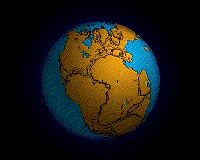 |
| Breakup of Pangaea. |
Paleogeography
and tectonics
Compared to the vigorous convergent plate
mountain-building of the late Paleozoic, Mesozoic
tectonic deformation was comparatively mild. The sole
major Mesozoic orogeny occurred in what is now the
Arctic, creating the Innuitian orogeny, the Brooks
Range, the Verkhoyansk and Cherskiy Ranges in Siberia,
and the Khingan Mountains in Manchuria.
This orogeny was related to the opening of the Arctic
Ocean and subduction of the North China and Siberian
cratons under the Pacific Ocean. In contrast, the era
featured the dramatic rifting of the supercontinent
Pangaea, which gradually split into a northern
continent, Laurasia, and a southern continent, Gondwana.
This created the passive continental margin that
characterizes most of the Atlantic coastline (such as
along the U.S. East Coast) today.
By the end of the era, the continents had rifted into
nearly their present forms, though not their present
positions. Laurasia became North America and Eurasia,
while Gondwana split into South America, Africa,
Australia, Antarctica and the Indian subcontinent, which
collided with the Asian plate during the Cenozoic,
giving rise to the Himalayas.
Climate
The Triassic was generally dry, a trend that began in
the late Carboniferous, and highly seasonal, especially
in the interior of Pangaea. Low sea levels may have also
exacerbated temperature extremes. With its high specific
heat capacity, water acts as a temperature-stabilizing
heat reservoir, and land areas near large bodies of
water—especially oceans—experience less variation in
temperature. Because much of Pangaea's land was distant
from its shores, temperatures fluctuated greatly, and
the interior probably included expansive deserts.
Abundant red beds and evaporites such as halite support
these conclusions, but some evidence suggests the
generally dry climate of was punctuated by episodes of
increased rainfall. The most important humid episodes
were the Carnian Pluvial Event and one in the Rhaetian,
a few million years before the Triassic–Jurassic
extinction event.
Sea levels began to rise during the Jurassic, probably
caused by an increase in seafloor spreading. The
formation of new crust beneath the surface displaced
ocean waters by as much as 200 m (656 ft) above today's
sea level, flooding coastal areas. Furthermore, Pangaea
began to rift into smaller divisions, creating new
shoreline around the Tethys Ocean. Temperatures
continued to increase, then began to stabilize. Humidity
also increased with the proximity of water, and deserts
retreated.
The climate of the Cretaceous is less certain and more
widely disputed. Probably, higher levels of carbon
dioxide in the atmosphere are thought to have almost
eliminated the north–south temperature gradient:
temperatures were about the same across the planet, and
about 10°C higher than today. The circulation of oxygen
to the deep ocean may also have been disrupted,
preventing the decomposition of large volumes of organic
matter, which was eventually deposited as "black shale".
Different studies have come to different conclusions
about the amount of oxygen in the atmosphere during
different parts of the Mesozoic, with some concluding
oxygen levels were lower than the current level (about
21%) throughout the Mesozoic, some concluding they were
lower in the Triassic and part of the Jurassic but
higher in the Cretaceous, and some concluding they were
higher throughout most or all of the Triassic, Jurassic
and Cretaceous. |
|
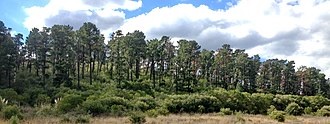 |
| Conifers were the
dominant terrestrial plants for most of the
Mesozoic, with grass becoming widespread in the
Late Cretaceous. Flowering plants appeared late
in the era but did not become widespread until
the Cenozoic. |
Life
Flora
The dominant land plant species of the time were
gymnosperms, which are vascular, cone-bearing,
non-flowering plants such as conifers that produce seeds
without a coating. This is opposed to the earth's
current flora, in which the dominant land plants in
terms of number of species are angiosperms. One
particular plant genus, Ginkgo, is thought to have
evolved at this time and is represented today by a
single species, Ginkgo biloba. As well, the extant genus
Sequoia is believed to have evolved in the Mesozoic.
Flowering plants radiated during the early Cretaceous,
first in the tropics, but the even temperature gradient
allowed them to spread toward the poles throughout the
period. By the end of the Cretaceous, angiosperms
dominated tree floras in many areas, although some
evidence suggests that biomass was still dominated by
cycads and ferns until after the Cretaceous–Paleogene
extinction. Some plant species had distributions that
were markedly different from succeeding periods; for
example, the Schizeales, a fern order, were skewed to
the Northern Hemisphere in the Mesozoic, but are now
better represented in the Southern Hemisphere.
Fauna
The extinction of nearly all animal species at the end
of the Permian period allowed for the radiation of many
new lifeforms. In particular, the extinction of the
large herbivorous pareiasaurs and carnivorous
gorgonopsians left those ecological niches empty. Some
were filled by the surviving cynodonts and dicynodonts,
the latter of which subsequently became extinct.
Recent research indicates that it took much longer for
the reestablishment of complex ecosystems with high
biodiversity, complex food webs, and specialized animals
in a variety of niches, beginning in the mid-Triassic 4M
to 6M years after the extinction, and not fully
proliferated until 30M years after the extinction.
Animal life was then dominated by various archosaurs:
dinosaurs, pterosaurs, and aquatic reptiles such as
ichthyosaurs, plesiosaurs, and mosasaurs.
The climatic changes of the late Jurassic and Cretaceous
favored further adaptive radiation. The Jurassic was the
height of archosaur diversity, and the first birds and
eutherian mammals also appeared. Some have argued that
insects diversified in symbiosis with angiosperms,
because insect anatomy, especially the mouth parts,
seems particularly well-suited for flowering plants.
However, all major insect mouth parts preceded
angiosperms, and insect diversification actually slowed
when they arrived, so their anatomy originally must have
been suited for some other purpose. |
|
|
|
|
|
|
|
|
|
|
|
|
|
|
|
|
|
|
Search Fun Easy English |
|
|
|
|
|
|
|
|
|
|
|
|
|
|
|
About
Contact
Copyright
Resources
Site Map |